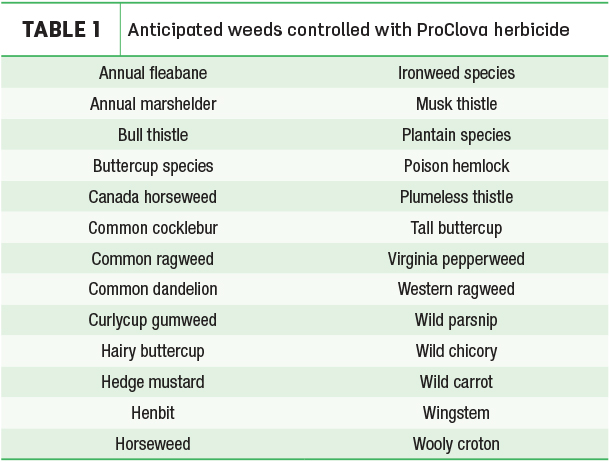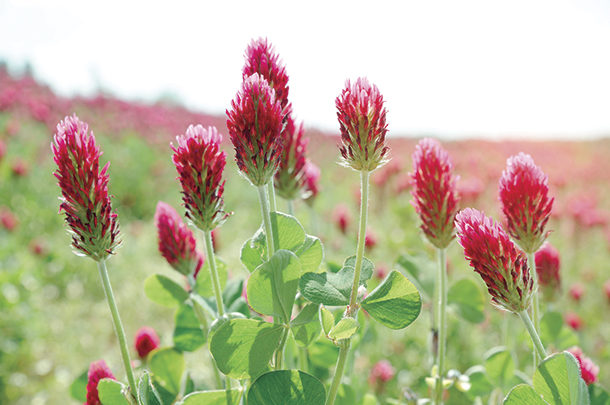The biology dictionary defines symbiotic relationship as an evolved interaction between organisms of different species, usually with benefits to one or both of the involved individuals. In the case of legumes, they supply all the necessary nutrients and energy to the bacteria, and the bacteria furnish nitrogen that is absorbed by the plants.
The large plant family of legumes is comprised of peas, beans and many important forage species such as alfalfa, clovers, lespedezas and vetch. Legumes are either winter annuals, summer annuals, biennials or perennials. In addition to their nitrogen value, they increase forage quality and can provide growth when grasses are dormant. Legumes can also reduce fescue toxicosis and grass tetany.
Benefits
“Legume nitrogen fixation begins with formation of nodules on the plant roots by rhizobia bacteria invading the plant tissue. Some legumes are better at fixing nitrogen than others,” says Robert Flynn, Ph.D., New Mexico State University. “Common beans are poor nitrogen contributors at less than 50 pounds per acre, which doesn’t completely meet their needs. Grain legumes such as peanuts, cowpeas, soybeans and fava beans are good contributors with the ability to produce up to 250 pounds of nitrogen per acre. Forage legumes such as alfalfa, sweetclover, true clovers and vetches may fix 250 to 500 pounds of nitrogen per acre.”
Nitrogen value of legumes depends on their percentage of pasture forage. A 50-50 mixture of grass and legume in a pasture can produce the same amount of grass as a similar pasture receiving more than 100 pounds per acre of commercial nitrogen fertilizer.
“An example of legume forage quality is a comparison with cool-season grasses,” says Keith Johnson, extension forage specialist at Purdue University. “Legumes have a greater percentage of protein and lower percent fiber, which translates to greater dry matter intake. There is also a faster cell wall digestion rate with legumes than cool-season grasses. An average of previous research shows that legumes growing in a cool-season grass pasture increased calf gains by 0.35 pounds per day.”
“Legume summer growth is important in areas where cool-season grasses are the primary forage. Addition of legumes to the pasture mix provides forage growth during the summer when very little production is obtained from cool-season grasses,” says Johnson.
“White clover is a cool-season forage, so it can lengthen the grazing season of warm-season pastures like bermudagrass and bahiagrass. White clover is generally productive in late winter to late spring and midfall to midwinter,” says Dennis Hancock, former forage extension specialist with University of Georgia Extension and now director of the U.S. Dairy Forage Research Center. “These periods are when warm-season perennial grasses are not productive or have low nutritive value.”
Fescue toxicosis is caused by an endophyte that lives inside the plant tissue. This fungus causes constricted blood vessels in cattle, which results in lameness and loss of extremities. It also elevates body temperature, reduces conception rates and milk production, and lowers average daily gain.
“Previously, the old cliché of ‘dilution is a solution’ was used as the explanation of how legumes reduced incidents of fescue toxicosis. Recently, however, it was learned that isoflavones in red clover relax blood vessels and reduce effects of fescue toxicosis,” says Johnson. (Isoflavones are secondary plant metabolites primarily produced by the leguminosae family.)
Grass tetany is most prevalent when cows in late gestation or heavy lactation graze lush spring growth. Rapidly growing grass contains low levels of magnesium, and its availability to the animal is further reduced by high levels of protein and potassium. Legumes are relatively high in magnesium and, thus, can help prevent grass tetany.
Constraints
Although legumes offer a lot of benefits to the grazing plan, there are also some constraints to their use. The good news is that it is possible to minimize most of the constraints with certain management practices.
Before planting a legume, test your soil for nutrient content and pH to use in species and variety selection. Regardless of the selected legume, it may require preplant applications of fertilizer and/or lime. Legumes require a soil pH of around 6 to 7, while cool-season grasses can provide optimum production at 5.5 to 6.5 pH. Applications of potassium are often necessary because grass requires less than legumes. Drainage is another soil property to consider, because its requirement varies among legumes. Alfalfa needs good drainage, and red clover withstands moderate drainage. White clover also has moderate tolerance to wet soils.
“Bloat is sometimes a constraint on planting legumes, but several non-bloating species are available such as sainfoin, cicer milkvetch, annual lespedeza, sericea lespedeza and birdsfoot trefoil. Sericea lespedeza is aggressive, so it may become a management problem. It is also prohibited for seeding in many states,” says Johnson.
Broadleaf control in legumes
Probably the biggest reason legumes are not planted is their intolerance to broadleaf weed herbicides, making weed control difficult. Help is on the way, however.
“White clover and annual lespedeza are tolerant to ProClova herbicide, a new product with registration in the U.S. expected in early 2021. The label will not require any grazing restrictions, and haying restrictions are minimal,” says Scott Flynn, Ph.D., Corteva Agriscience. “There is short plant-back of 15 days for pastures and native plantings, and the herbicide has no soil residual activity. Research continues to identify additional tolerant legumes and susceptible broadleaf weeds.” Anticipated weeds controlled by the new chemistry are listed in Table 1.

Another possible constraint is excessive protein intake by dairy cattle grazing lush, vegetative legumes, where greater than 20% crude protein content can occur. The excess protein over animal requirements is converted to blood urea nitrogen (BUN), which causes increased prostaglandin production. Elevated levels of prostaglandin can interfere with early embryo development and cause early embryo mortality.
“Research has not shown a connection between BUN concentrations and beef cattle fertility,” says Patrick Guinn of Iowa State University. “It is suggested that the relationship in dairy cattle has to do with metabolic stressors and negative energy balances during peak lactation, which occurs during breeding season.”
“Properly managed grasses are more resistant to plant diseases, whereas legumes have less tolerance,” says Johnson. “Disease can thin legumes to the point they require reseeding into a grass-dominant environment. The required renovation process is often expensive. Alfalfa is autotoxic, meaning an established plant produces a toxin that prohibits seedling development in a 16-inch diameter.”
Before adding legumes to grass pastures, determine if the benefits outweigh the constraints. Will legumes fit your ranch environment and management style? The most important consideration is whether adding legumes to your grass pastures will be economically beneficial. For many operations, the benefits of legumes will add profitability as well as sustainability. ![]()
Getty Images.
Robert Fears is a freelance writer based in Georgetown, Texas.











